|
|
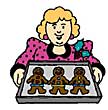 Gingerbread Throughout History: A Sweet Holiday Retrospective Gingerbread Throughout History: A Sweet Holiday Retrospective
by Marjorie Dorfman
What is the origin of gingerbread and how did it become associated with the Christmas season? These and other scrumptious issues linger below, that is, if you dare to not even think the word "diet" and can stand a wondrous sniff.
|
And I had but one penny in the world. Thou should’st have it to buy gingerbread. – William Shakespeare, Love’s Labours Lost
The origins of gingerbread are steeped in a flavorful tradition, and date back to the ancient world. Ginger root is Malaysian, and was once used to soothe an upset stomach and prevent a cold. In 2000 BC wealthy Greek families sailed to the isle of Rhodes to buy "spiced honey cakes." Throughout pre-Christian Europe, the Winter Solstice was celebrated with the creation and ingestion of small gingerbread cakes adorned with symbols of the sun. Today, gingerbread and other deserts are given as Christmas gifts for loved ones.
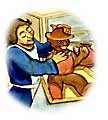 The First Crusades of the eleventh century heralded the return of weary pilgrims and soldiers from the Middle East. They brought with them a mysterious and heretofore unknown succession of ingredients that would become the mainstay for the gingerbread recipe. These included spices, (ginger) sugars, almonds and citrus fruits. Catholic monks began to bake gingerbread for special religious celebrations, constructing the cakes into specific designs. Often depicting saints and other religious motifs, these wonderful early carvings were made via large and elaborately carved "cookie boards" that impressed the pattern onto a stiff rolled dough. (Today, these depictions can only be seen in some museums and are very rare.) The First Crusades of the eleventh century heralded the return of weary pilgrims and soldiers from the Middle East. They brought with them a mysterious and heretofore unknown succession of ingredients that would become the mainstay for the gingerbread recipe. These included spices, (ginger) sugars, almonds and citrus fruits. Catholic monks began to bake gingerbread for special religious celebrations, constructing the cakes into specific designs. Often depicting saints and other religious motifs, these wonderful early carvings were made via large and elaborately carved "cookie boards" that impressed the pattern onto a stiff rolled dough. (Today, these depictions can only be seen in some museums and are very rare.)
Two hundred years later, (around 1300) the English added bread crumbs to the mixture of spices and developed "ginger candy." Often the bread used was stale and the spices had to be very heavy in order to disguise this fact as well as the taste. Hence, gingerbread in its modern form reared its lovely and most sumptuous head.
Gingerbread became so popular during medieval times that many festivities were actually known as "gingerbread fairs." In England the alternative name of "fairings" came to mean a gift given at or brought from a fair. Early bakers created certain shapes in association with the different seasons of the year. During the spring, buttons and flowers were the most prevalent motifs, while in autumn animals and birds predominated. Forms were generally inspired by the commonplace images of daily life. During the seventeenth and eighteenth centuries, decorative themes expanded to include elaborate depictions of lords, ladies, soldiers, castles and occasionally floral and geometric designs.
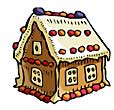 The term gingerbread does not tell the whole story or even more than just a little delicious part of it. In Medieval England gingerbread meant simply "preserved ginger" and was actually a corruption of the Old French gingebras, derived from the Latin name of the spice, Zingebar. The term was not applied to a kind of cake made with treacle and flavored with ginger until the 15th century. It is probably no accident that recipes for cakes, cookies and flavored breads developed rapidly after it was discovered that ginger had a preservative effect when added to pastries and bread. The term gingerbread does not tell the whole story or even more than just a little delicious part of it. In Medieval England gingerbread meant simply "preserved ginger" and was actually a corruption of the Old French gingebras, derived from the Latin name of the spice, Zingebar. The term was not applied to a kind of cake made with treacle and flavored with ginger until the 15th century. It is probably no accident that recipes for cakes, cookies and flavored breads developed rapidly after it was discovered that ginger had a preservative effect when added to pastries and bread.
Each country maintained its own variation of gingerbread. In some places, it took the form of a soft, spiced cake while in others it was a crisp flat cookie. Still other modifications called for thick dark squares of bread that were sometimes served with whipped cream or lemon sauce. (Diets be damned or at least go away until the next gingerbread day!) Of all the countries in Europe, Germany has the most enduring tradition of flat, shaped gingerbreads. Even today, throughout Germany at every autumn fair, there are rows of stalls filled with hundreds of gingerbread hearts, decorated with white and colored icing and tied with ribbons.
Of all the German cities, Nuremberg became known as the "gingerbread capital" of the world. Sculptors, painters, woodcarvers and goldsmiths all contributed in the creation of the most beautiful cakes in Europe. Gifted craftsmen carved wooden molds and talented artists assisted with the frosting. Many of these designs were actually objets d’art, varied and incredibly fancy, depicting angels, hearts and wreaths.
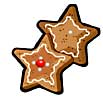 Nuremberg gingerbread was not baked in the home. It was the exclusive production of a Guild of master bakers known as the Lebkuchler. Their creations known as lebuucken, called for all of the flavorings and ingredients available at the time. These included cardamom, cloves, cinnamon, white pepper, anise and ginger. Larger pieces of gingerbread even today are used to build hexenhaeusle (witches’ houses) and are also referred to as Knusperhaeuschen (houses for nibbling at). Nuremberg gingerbread was not baked in the home. It was the exclusive production of a Guild of master bakers known as the Lebkuchler. Their creations known as lebuucken, called for all of the flavorings and ingredients available at the time. These included cardamom, cloves, cinnamon, white pepper, anise and ginger. Larger pieces of gingerbread even today are used to build hexenhaeusle (witches’ houses) and are also referred to as Knusperhaeuschen (houses for nibbling at).
|
|
|
|
 |
|
|
Don't miss this excellent book:
Making Great Gingerbread Houses:
Delicious Designs from Cabins to Castles, from Lighthouses to Tree Houses
by Paige Gilchrist
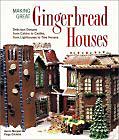
This book is all you need to make gingerbread houses – whether you're a beginner or an expert. Professional gingerbread maker Aaron Morgan walks you step-by-step through the process of building a basic gingerbread house, using how-to photos and easy-to-follow instructions.
|

Click for a printer friendly version of this article.
|
|